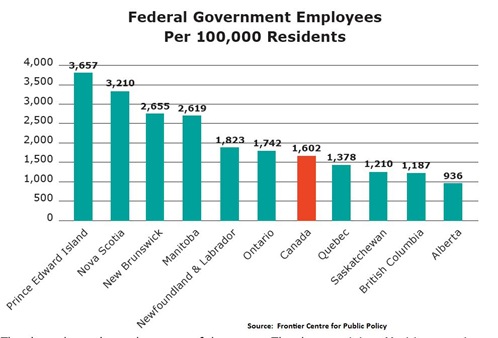Far from being hard done-by when it comes to federal jobs in the province, Newfoundland and Labrador is pretty much on par, according to a recent study conducted by the Frontier Centre for Public Policy, and reported by the National Post.
You can find a news release summarising the report here, while the full report is available in pdf format.
Some provinces - Prince Edward Island, New Brunswick, Nova Scotia and Manitoba – have significantly more than the national average number of federal jobs per 100,000 population. Quebec, Saskatchewan, British Columbia and Alberta have less.
Newfoundland and Labrador and Ontario are only slightly higher than the national average.
The study effectively refutes claims that this province is receiving something less than its “entitlement’ to federal pork spending. The comparative figures also demolish two reports released by Memorial University’s Harris Centre in 2005 and 2006. The provincial government has used those studies repeatedly to bolster its claims for increased federal transfers to the province to offset what turn out to be imaginary grievances.
The Frontier Centre study refers to these federal jobs as a form of “stealth” Equalization. That is, they contend that the federal jobs serve as a type of federal transfer to the local economy in each of the provinces. More importantly, though, the Frontier Centre contends that the transfer comes in addition to the formal Equalization program and is particularly heavy in the provinces it refers to as “major” have-provinces.
The study also notes that the have-not provinces with the highest ratio of federal government jobs also tend to have higher than average reliance on provincial public sector jobs generally. They compare provinces based on the number of public sector employers as a share of the total population. Newfoundland and Labrador is third highest on that scale, with Prince Edward Island and Manitoba coming, respectively, first and second.
Looking at the same information but as a share of the provincial labour force, Newfoundland and Labrador is by far the province with the largest dependence on the public sector. Almost 30% of the provincial labour force is employed by the federal, provincial or municipal government.
The Frontier Centre study puts the findings into a particular context, namely transfer payment reform:
The stealth equalization of unbalanced federal employment described in this paper is part of a much bigger problem —an approach to public policy in Canada that transfers money out of high-productivity regions into low-productivity regions.
Not only is this policy approach harmful to our productivity growth, it is also, quite simply, unsustainable. Historically, the taxpayers in three provinces—British Columbia, Alberta and Ontario, have paid most of the bill for high levels of public sector employment in the have-not provinces.
At the same time, the study does point to issues that are especially relevant to Newfoundland and Labrador, even if the report’s authors simply missed the poster child for their argument of unsustainable public spending and the dangers of reliance on what the author’s call “the state driven approach to economic development”.
Most residents of the recipient provinces are unaware of the extent to which their economies are state-driven and reliant on transfers. Beyond the official equalization money, massive amounts of revenue from elsewhere flow into these provinces from a number of different sources. Stealth equalization through federal employment is one important example—but there are others. Higher dependence on federal
government transfers to individuals and discrimination in ordinary operating programs in favour of the have-nots are two more examples of ways Canadian public policy transfers wealth into the have-nots.
Most residents of Newfoundland and Labrador are unaware of the extent to which the provincial economy is state-driven and reliant on federal transfers in addition to overall public sector spending.
They aren’t alone, of course. The current provincial administration operates as if going off Equalization was a tragedy of biblical proportions.
- srbp -
Related:
- Fragile Economy: staying the course
- Fragile Economy: reductio ad argentum
- Fragile Economy: The public sector
- Fragile Economy: …and two steps back
- Fragile Economy: …now three steps back and loving it
